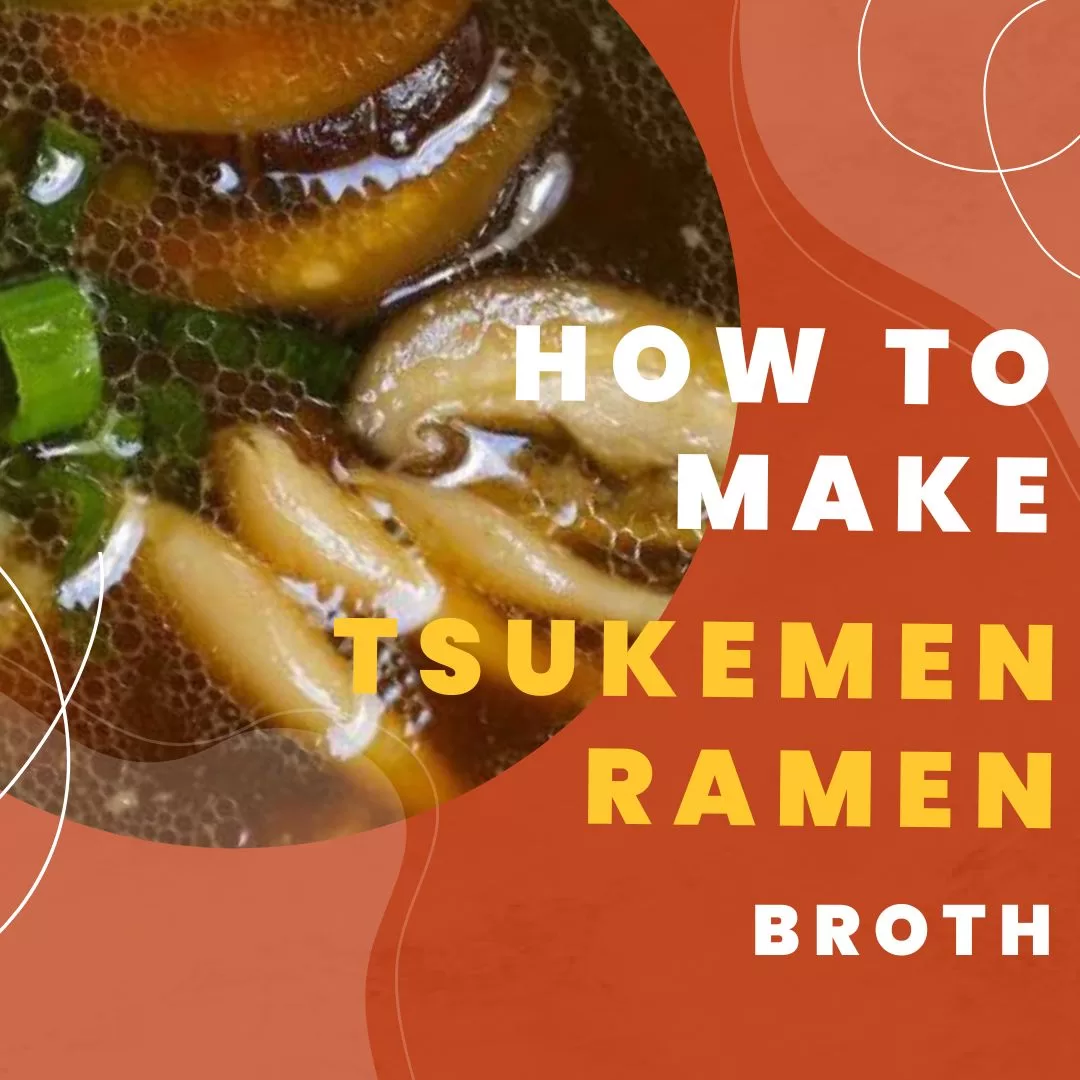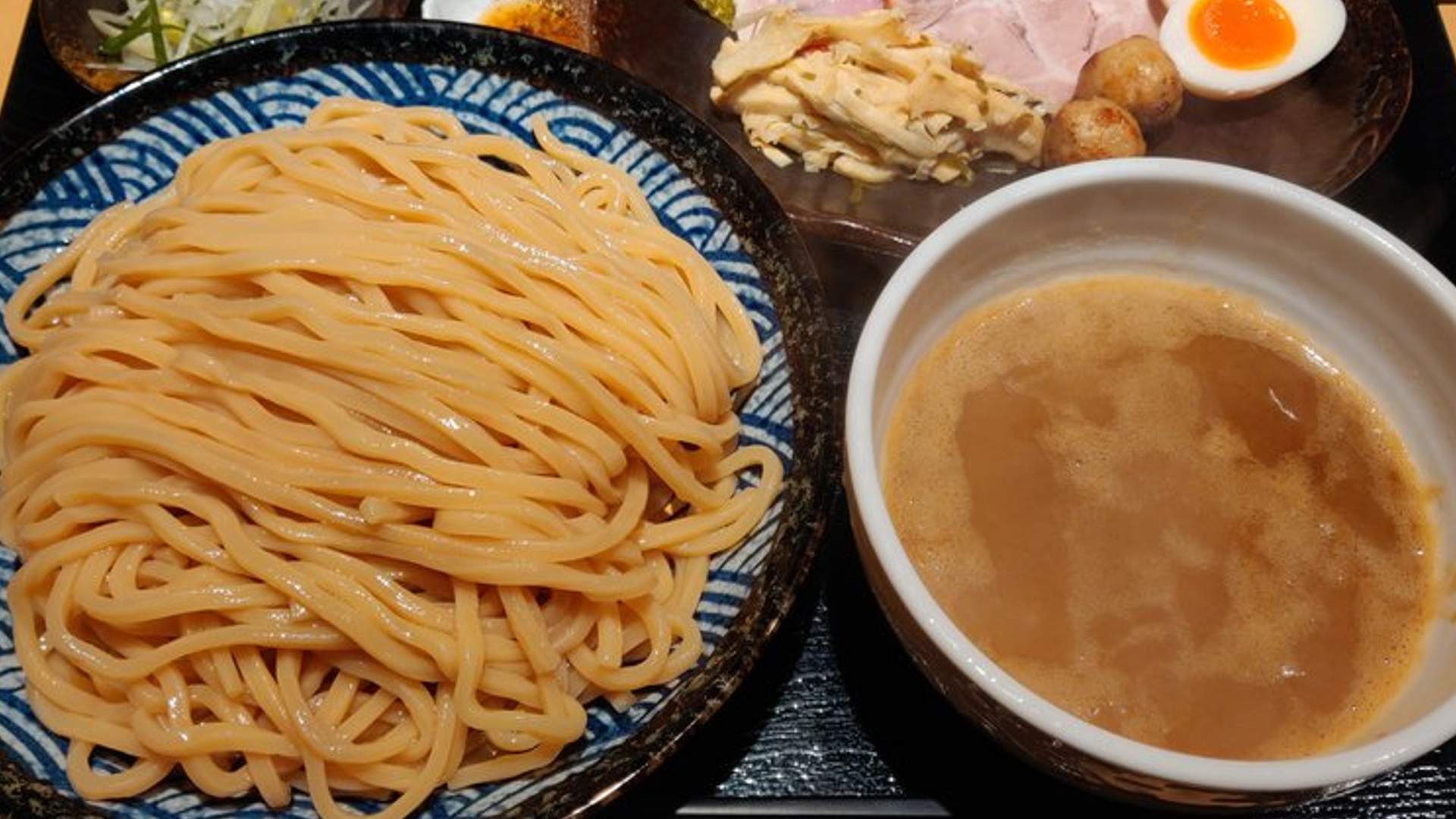How To Make Tsukemen Ramen Broth


Tsukemen is a ramen dish where the ramen noodles and ramen broth are served separately. This Japanese cuisine consists of noodles which are eaten after being dipped in a separate bowl of soup or broth. It was created by Kazuo Yamagishi in 1961, who is a restaurateur in Tokyo, Japan. Tsukemen ramen has become a very popular dish in Tokyo and throughout Japan.
What’s exciting about Tsukemen ramen is that its fresh ramen noodles are served as cold noodles and dipped into a hot broth. Dipping noodles and the toppings is a very enjoyable experience of the Tsukemen ramen. The cold ramen noodles served with a hot soup creates a one of a kind contrast that everyone would love.
The broth can be made with store-bought meat or vegetable stock. You can also create the dipping sauce with water and mentsuyu, a Japanese soup base consisting of kombu and katsuobushi (dried bonito flakes) simmered in soy sauce, sake, mirin.
Tsukemen dipping ramen noodles is a versatile dish that can be served in any weather, even in the summer. If you are craving for some cold ramen dipped into a bowl of intensely flavorful hot soup, find out how to recreate the recipe as you read further.
Origin of Tsukemen Ramen
In the late 50s, Kazuo Yamagishi collaborated with his relative Masayasu Sakaguchi and created these Japanese dipping ramen noodles as they owned famous Taishoken ramen restaurants in Tokyo.
During the hot days of summer, their staff would eat leftover ramen noodles and dip it into a hot soup flavored with soy sauce. Since the customers have seen how the staff enjoyed their meal, they began ordering and requested to try out the dish. That’s when the owners decided to put up the dish on their menu.
It is then called Tsukemen ramen and the Japanese keyword got out and Tsukemen’s popularity started to spread across Japan during the 1970s and 80s. This ramen is now famous in specialty shops throughout Japan serving a variety of Tsukemen dishes. In 2019, the Tsukemen ramen was brought to the US as Taishoken opened its first location in San Mateo and started serving Tsukemen to the Americans.
What Are the Differences between Ramen and Tsukemen?
The distinguishing factor between Tsukemen and the standard ramen noodle soup would be the way they are prepared and how you would eat them. With Tsukemen ramen, you will dip the ramen noodles that are chilled or at room temperature into the hot soup or Tsukemen broth before eating them. Whereas the regular ramen would assemble all ingredients into a bowl and you can start digging in.
Dipping ramen noodles into the Tsukemen broth is more practical when it comes to preserving the firmness of the fresh ramen noodles while having a hot broth that stays hot enough to flavor and moistens the ramen noodles. This is also one of the reasons why when eating Tsukemen dipping ramen noodles, it is important to choose the best quality of cold ramen noodles.
Eating Tsukemen ramen would mean you will be tasting more of the noodles than the Tsukemen broth. The quality and texture of the ramen noodles is being judged to say that it is a good bowl of Tsukemen ramen. Some specialty shops would prefer serving homemade thicker, chewier, and springy noodles as their texture provides wider surface areas to absorb the dipping sauce.
When it comes to the dipping sauce, it is made to be saltier and more intense flavor than the typical ramen broth as it is mainly used for dipping and not for slurping, unlike with the regular ramen recipe.
What Are the Essential Ingredients for Tsukemen Ramen?
When making your own Tsukemen dipping noodles recipe, it is important to familiarize yourself with the ingredients and possible substitute ingredients for the dish. Tsukemen noodles should be of the best quality as it plays a great role in creating the best, and getting fresh ramen noodles which you can find at local Japanese grocery stores or online would be a great thing to do. As a substitute, dry ramen noodles can be used if you can find any fresh ramen noodles in the area.
To add some unique layer of flavor to the soup broth, put in thinly sliced pork belly. If you don’t have some fatty pork belly, use bacon as a substitute. Fresh garlic and fresh ginger should also be used for some great flavor on your noodle soup base.
Vegetable oil is a pinnacle of your Tsukemen sauce, so don’t substitute it with an extra virgin olive oil. Chicken stock also adds so much flavor to the dipping soup, make sure to get some when making your Tsukemen sauce or dipping sauce. If you want something healthier, use reduced sodium to lower the salt intake.
For the soy sauce, you can use the low-sodium soy sauce or the regular soy sauce depending on your preference and recipe. Green onions are also essential. The white part of the green onion can be used for the broth, while the green part is for garnish before you eat Tsukemen.
Since mushrooms are used for toppings, you can get both shiitake mushrooms and Shimeji mushrooms. If you have a preferred mushroom, you can also use that before you serve Tsukemen noodles.
Mirin is an essential condiment in Japanese cuisine, and it is used for Japanese dipping. It adds a sweet and tangy flavor when making Tsukemen broth. Rice vinegar adds a nice acidity to the soup broth, with a little lip-twisting zing. It is a great balancer for the rich and sweet flavors. If you can’t find rice vinegar, use white vinegar instead.
Depending on your preferred taste, you can add salt and pepper before serving your Tsukemen noodles. Most ramen shops usually place this on the table ready to be used. If you want an authentic nutty flavor to the dish, add sesame oil and sesame seeds. Soft-boiled eggs are usually served as toppings on traditional Tsukemen.
Recipe to Create Tsukemen Ramen Broth
There are several types of soups and flavors that can be used for dipping noodles for Tsukemen, just like how many types of ramen noodles that are available for the cold noodles. This recipe will provide information on how you can make the noodles al dente, make Tsukemen broth and how to create the perfect soft-boiled eggs for the toppings.
For the fresh ingredients, you will need to prepare:
For Ramen Noodles:
2 packages ramen noodles (this recipe makes 2 servings, 4-oz if fresh noodles, or 2-oz if dry noodles for each serving)
For Tsukemen Broth:
- 1/2 tablespoon of vegetable oil
- 1/2 lb. of pork belly (thinly sliced, use bacon as a substitute)
- 2 cloves of garlic (minced)
- 2 teaspoon of freshly grated ginger
- 2 cups of chicken stock
- 3 tablespoons of low-sodium soy sauce or regular soy sauce
- 2 green onions or scallions
- 2 shiitake mushrooms (or your preferred mushrooms)
- 1/2 cup of Shimeji mushrooms (or your preferred mushrooms)
- 2 tablespoons of mirin (use dry sherry or cooking wine if you prefer)
- 1/2 teaspoon rice vinegar (substitute with white vinegar or apple cider vinegar)
- salt and pepper to taste
- 1 teaspoon of sesame oil
For Toppings:
- 2 soft-boiled eggs
- chopped green onions
Procedures:
How to Cook Ramen Noodles
- In a large pot, bring water to a boil and add the ramen noodles. Cook the ramen noodles according to the packaging instructions.
- Rinse the noodles under running water once cooked and soak them in a bowl of cold water to cool.
- Drain the ramen noodles completely and divide them into 2 bowls and set aside.
How to Make Tsukemen Broth
- Prepare the ingredients that need to be cut, minced or sliced.
Cut the pork belly into thin slices and cut them into 2-inch pieces; mince the garlic and ginger; chop the green onions, and slice the mushrooms.
- In a large pot, heat the vegetable oil over medium heat.
Add garlic and ginger, and cook for about 1-2 minutes or until fragrant while stirring frequently.
- Add the thinly sliced pork belly and stir-fry until light brown in color.
Stir in chicken stock, soy sauce and mirin.
- Cover the pot and bring to a boil.
Once you have a boiling water or broth, remove the lid and lower the heat. Simmer for about 10 minutes. You can make soft-boiled eggs while waiting. Just follow the instructions provided below
- After 10 minutes, add the green onions and mushrooms and bring them to a boil on high heat.
- Once it boils, bring the heat to low and simmer for another 5 minutes until the mushroom has softened.
- Put some sesame oil and vinegar and season with salt and pepper to taste. Stir the broth lightly then remove from heat and set aside.
How to Cook Soft-Boiled Eggs
- Put water on a saucepan to the brim and bring it to a boil. Get your cold-from-the-fridge eggs and gently lower them into the water, making sure they are covered well with the water.
- Simmer for 7 ½ minutes and adjust the temperature as necessary to maintain a gently boiling water.
- In an ice bath or ice water, put the boiled eggs and chill for 3 minutes. Crack the eggs all over and peel the shell gently. Slice the peeled eggs in half lengthwise.
How to Serve this Tsukemen Recipe
- Get your cooked ramen noodles and place them into individual bowls.
- Put soft-boiled eggs on top of the ramen noodles.
- In a separate bowl, add the Tsukemen broth and vegetables. Top it with chopped green onions. You can now enjoy eating your Tsukemen by dipping noodles into the perfectly cooked broth.





